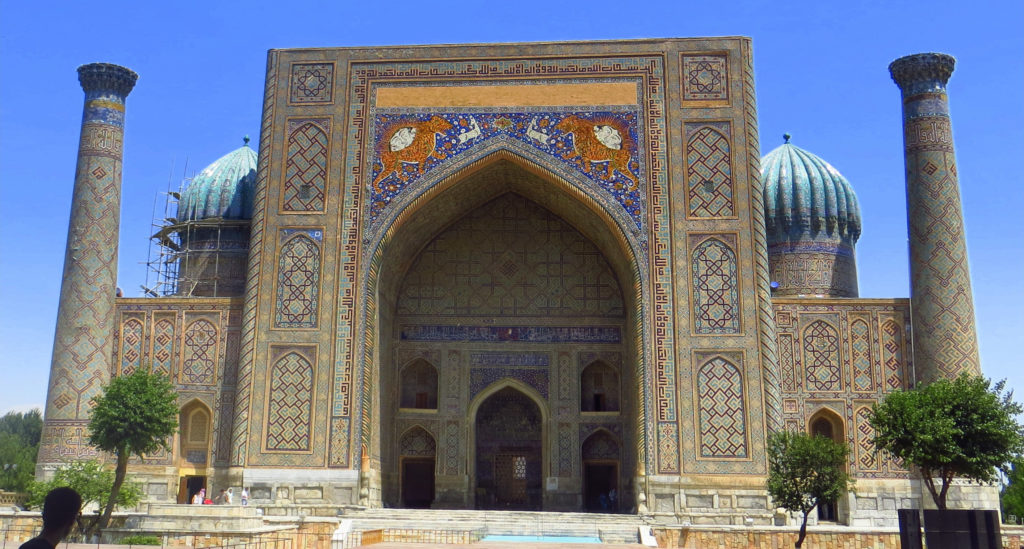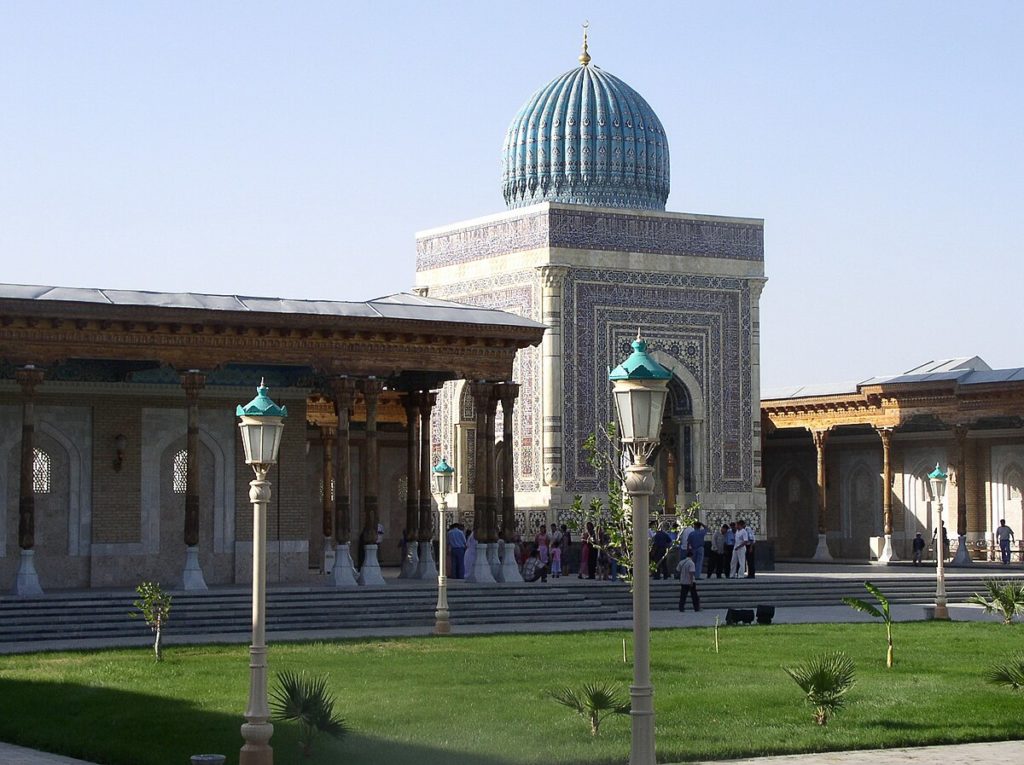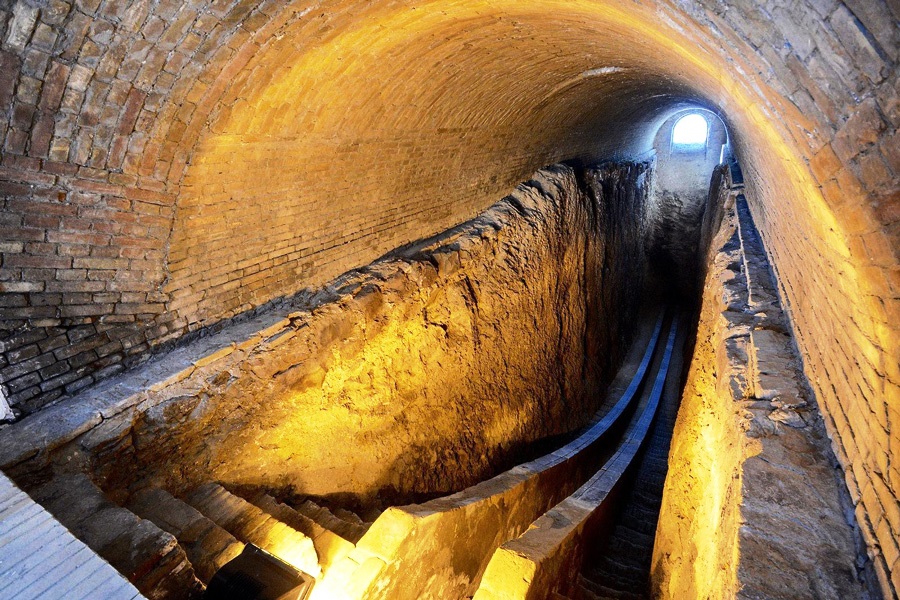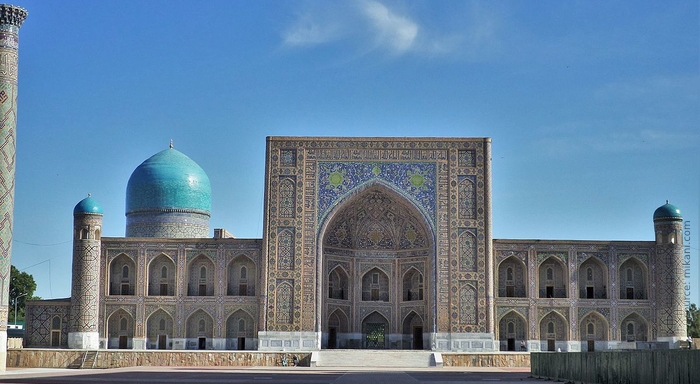Sher-Dor Madrassah was built on the Registan Square, Samarkand in 1619-1636. The name is translated as Madrassah with Lions. It is the distorted and exaggerated reflection of the Ulugbek Madrassah, which is located just opposite, on the western side of the Registan Square. The difference in age between them is 200 years. Sher-Dor has larger area and sizes, but it yields to its elder brother by the quality of finishing works.
On the outside and inside this Madrassah is decorated with bright ornaments of glazed brick, walls and towers are covered with majolica of various patterns of climber flowers and quotations from Koran on Arabic. But some part of finishing is irretrievably lost, though scientists, historians and restorers try to recover the initial appearance of Sher-Dor Madrassah.
By architecture the Sher-Dor Madrassah almost repeats the Ulugbek Madrassah, i.e. it is the square building with inner yard, khudjras (cells) for students and two rooms for classes. The Madrassah was considered as the modern building of that time, because the latest architectural innovations were used at the construction. Moreover such grand building has a set of constructive peculiarities, which make it one of the best architectural monuments in Samarkand.
In addition the Madrassah of Sher-Dor has some features. In the center of the arch above the entrance there is the image of swastika, which from ancient times was the symbol of abundance and fertility. Also there are images of tigers with the sun on their backs on each side of the arch.
For the whole period of existence the Madrassah of Sher-Dor has been restored many times. The largest works were conducted in the beginning of XX century by Soviet architect, out of them the most famous was V.G. Shukhov. Today this monument of Samarkand architecture is one of the main sights of the city. In 2001 the Madrassah of Sher-Dor entered the UNESCO World Heritage List.
Bibi-Khanym Mosque was constructed to mimic the design of the Amir Temurasa cathedral mosque of Samarkand. It was intended to out-rival everything he had ever seen. Architects, artists and craftsmen from conquered countries were involved in the construction of this grandiose complex. Elephants were used for lifting and transporting heavy loads. The mosque was constructed over five years. When Temur returned after his western campaign, he was very disappointed by the construction and ordered the reconstruction of the portal, which he deemed not high enough.
In the end, the cathedral mosque was given one of the greatest portals of that era. Its arch was flanked with powerful pylons, with minarets up to 50m in height. The front entrance had bronze doors with the inscription: “The sound of these huge doors, made from the alloys of seven metals, calls the prayers of seven climates into the house of Islam”.
The gates were taken away from Samarkand by Iranian Shah Nadir in 1740. Above the portal there was an inscription: “The dwelling of creatures is all hypocrisy, falsehood and passions. Everything is concentrated at the threshold of the Lord’s hall – and only there…”
Today, the marble lectern for the tremendous Koran made at Ulugbeg stands in the center of the courtyard.
The cathedral mosque of Samarkand was named after the oldest wife of Amir Temur, Bibi-Khanym. She was Sarai Mulk-Khanym, a daughter of Kazan-khan (1343-1346). In the 1340s, Kazan-khan and his brother, Halil-suitan, subordinated Maverannahr and southeastern Khurasan.
However, soon they suffered defeat at the hands of Chagataid amir Kazagan (1346-1358). Sarai Mulk-Khanym became the wife of Emir Hussein, the grandson of amir Kazagan, who was a supreme Chagataid governor in 1364-1370. Amir Temur made Sarai Mulk-Khanym his wife when he dethroned Hussein. That gave him the honored title of Guragan – “Khan’s son-in-law”.
A large madrassah had been located opposite to the cathedral mosque until the middle of the 18th century. It had carried the name of Bibi-Khanym too. Originally, the madrassah’s portal was so large that it competed with the cathedral mosque. It made Amir Temur angry and he ordered its reconstruction. The madrassah was destroyed during the invasion of Nadir-Shah. There is a mausoleum on the central axis of the madrassah. It is a tomb of Sarai Mulk-Khanym’s mother and two other women from her family. This is a high octahedral structure with a cylindrical drum, bearing a Kufi inscription. The interior is decorated with mosaics and floral ornamentation, including landscapes of the garden of eden.




